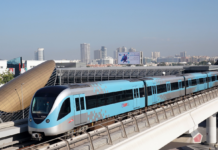By Eugene Harnan www.thenational.ae

The huge number of riders which included fun-seekers attracted by the novelty of the rail line has caused problems. But now that the holidays are over, officials expect the number of joyriders to decrease and regular travel to settle down.
According to the Roads and Transport Authority, the Metro carried 1,018,030 passengers in the first 16 days after the 52km Red Line opened on September 9.
The Mall of the Emirates was the most popular stop, with 192,585 passengers using the station there. The mall has been very crowded, especially at weekends, and some people have had to wait more than an hour to enter the station.
The next most popular stop was Rashidiya, at the opposite end of the Red Line, with 147,741 passengers. Rashidiya has parking for nearly 3,000 cars.
Over the three days of Eid, 266,671 passengers passed through the 10 stations that are open along the Red Line. Long queues stretched out of the stations, caused by faulty ticketing machines and confused passengers who held up others because of a lack of information about the pricing and type of cards available.
Even though the number of weekend riders has dropped slightly since the Metro opened, an RTA official said changes have been made to deal with the huge crowds that continue to swarm some stations.
“We’ve added a lot of staff to the stations and more selling points for tickets in the stations, and embarked on a heavy marketing campaign to educate people on how to use the Metro and the Nol [fare] cards,” said Peyman Younes Parham, the director of marketing and corporate communications for the RTA.
Almost 200,000 passengers rode on the Metro in its first three days. The second weekend drew 125,000 riders, and last weekend the number was 115,000.
According to a Dubai-based psychologist, many people were attracted to the Metro simply because it was new.
“The ride on the new Metro can be compared to a new attraction in a big fun park like a roller-coaster riding just for fun,” said Dr Hartmut Kollikowski of Dubai’s German Centre for Neurology and Psychiatry.
“Most probably this phenomenon will disappear after the first period of excitement has passed. In the future, the Metro will be seen more like a sensible transport possibility than a holiday attraction.”
It was not an easy first 16 days for the Metro’s operators, who had to deal with unexpected long queues and delays.
Authorities attributed many problems to passengers pressing the emergency stop buttons when platform doors would not synchronise with the train doors, causing the entire system to shut down for safety reasons.
Dr Kollikowski said the technical glitches and passengers’ unfamiliarity with what to do if a train breaks down could have led to panic.
“As there is no driver on the train, a feeling of loss of control or panic might have arisen in some of the commuters,” he said. “This might have lead to misusing the emergency button several times to get out of the running train.”
He also said pushing the emergency button may have given some commuters a feeling of safety and power.
“In a car, the driver is master of his own steering wheel thus controlling the car himself,” he said. “On the airplane, there is a pilot and a co-pilot on board who navigate the plane just like a captain and his crew on board of a ship.”
















